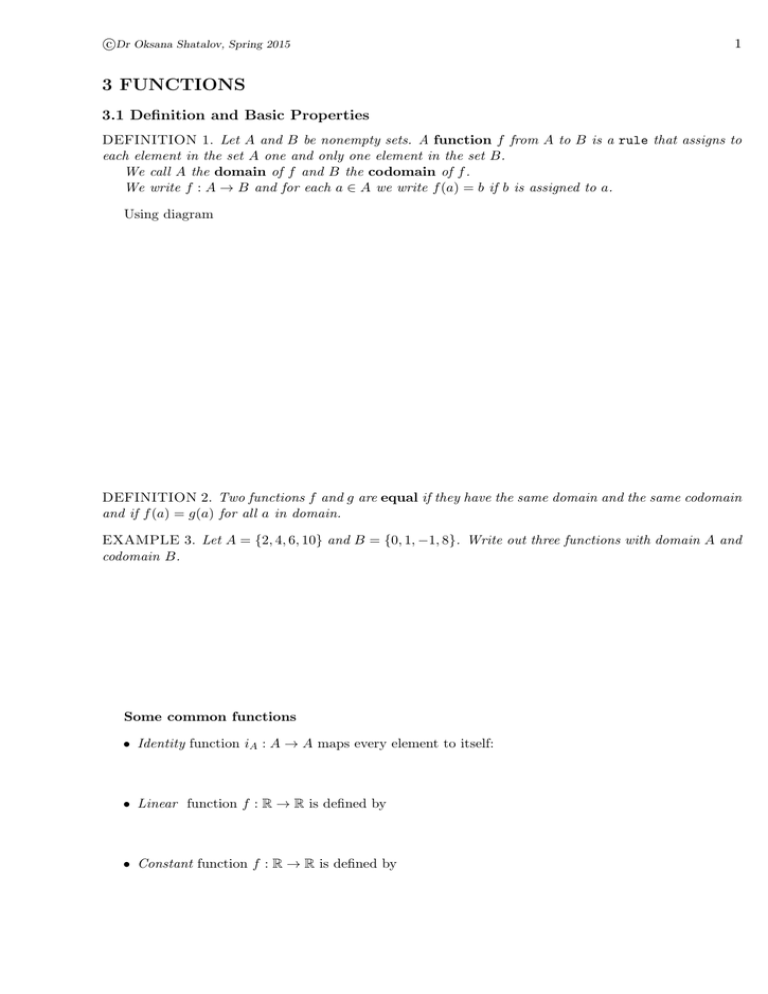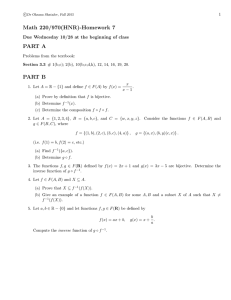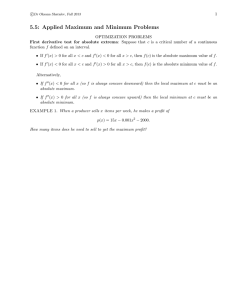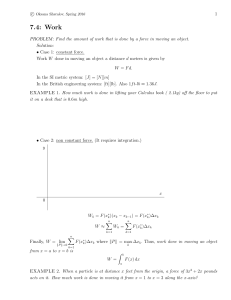Document 10581917
advertisement

c Dr Oksana Shatalov, Spring 2015
1
3 FUNCTIONS
3.1 Definition and Basic Properties
DEFINITION 1. Let A and B be nonempty sets. A function f from A to B is a rule that assigns to
each element in the set A one and only one element in the set B.
We call A the domain of f and B the codomain of f .
We write f : A → B and for each a ∈ A we write f (a) = b if b is assigned to a.
Using diagram
DEFINITION 2. Two functions f and g are equal if they have the same domain and the same codomain
and if f (a) = g(a) for all a in domain.
EXAMPLE 3. Let A = {2, 4, 6, 10} and B = {0, 1, −1, 8}. Write out three functions with domain A and
codomain B.
Some common functions
• Identity function iA : A → A maps every element to itself:
• Linear function f : R → R is defined by
• Constant function f : R → R is defined by
c Dr Oksana Shatalov, Spring 2015
2
Image of a Function
EXAMPLE 4. Discuss codomain of f (x) = x4 .
DEFINITION 5. Let f : A → B be a function. The image of f is
Im(f ) = {y ∈ B|y = f (x) f or some
x ∈ A} .
EXAMPLE 6. Let f, g : R → R be defined by f (x) = cos x and g(x) = |cos x| . Find Im(f ) and Im(g).
Image of a Set
DEFINITION 7. Let f : A → B be a function. If X ⊆ A, we define f (X), the image of X under f , by
f (X) = {y ∈ B|y = f (x) f or some
x ∈ X} .
c Dr Oksana Shatalov, Spring 2015
3
Question: Let f : A → B be a function. What is f (A)?
EXAMPLE 8. f : R → R is defined by f (x) = cos x. Find f ([−π/2, π/2]).
Inverse Image
DEFINITION 9. Let f : A → B be a function and let W be a subset of its codomain (i.e. W ⊆ B).
Then the inverse image of W (written f −1 (W )) is the set
f −1 (W ) = {a ∈ A|f (a) ∈ W } .
EXAMPLE 10. Let A = {a, b, c, d, e, f } and B = {7, 9, 11, 12, 13} and let the function g : A → B be
given by
g(a) = 11, g(b) = 9, g(c) = 9, g(d) = 11, g(e) = 9, g(f ) = 7.
Find
f −1 ({7, 9}) =
f −1 ({12, 13}) =
f −1 ({11, 12}) =
Summary
Let f : A → B. The above definitions imply the following tautologies
• (y ∈ Im(f )) ⇔ (∃x ∈ A 3 f (x) = y).
• (y ∈ f (X)) ⇔ (∃x ∈ X 3 f (x) = y).
• (x ∈ f −1 (W )) ⇔ (f (x) ∈ W ).
• If W ⊆ Im(f ) then (S = f −1 (W )) ⇒ (f (S) = W ).
c Dr Oksana Shatalov, Spring 2015
4
EXAMPLE 11. Let S = {y ∈ R|y ≥ 0} . Prove that if f : R → R is defined by f (x) = x4 then Im(f ) = S.
EXAMPLE 12. f : R → R is defined by f (x) = 5x − 4. Find f ([0, 1]). Justify your answer.
c Dr Oksana Shatalov, Spring 2015
5
EXAMPLE 13. f : R → R is defined by f (x) = 3x + 4. Let W = {x ∈ R|x > 0} . Find f −1 (W ).
EXAMPLE 14. f : Z → Z is defined by
f (n) =
n − 1 if n is even,
n + 1 if n is odd.
Prove that f (E) = O.
EXAMPLE 15. f : Z → Z is defined by
f (n) =
Compute
(a) f −1 ({6, 7}) =
(b) f −1 (O)
n/2
if n ∈ E,
n + 1 if n ∈ O.
c Dr Oksana Shatalov, Spring 2015
6
PROPOSITION 16. Let A and B be nonempty sets and f : A → B be a function. If X ⊆ Y ⊆ A then
f (X) ⊆ f (Y ).
Proof.
PROPOSITION 17. Let A and B be nonempty sets and f : A → B be a function. If X ⊆ A and Y ⊆ A
then
(a) f (X ∪ Y ) = f (X) ∪ f (Y ).
(b) f (X ∩ Y ) ⊆ f (X) ∩ f (Y ).
Proof
c Dr Oksana Shatalov, Spring 2015
7
PROPOSITION 18. Let A and B be nonempty sets and f : A → B be a function. If W and V are
subsets of B then
(a) f −1 (W ∪ V ) = f −1 (W ) ∪ f −1 (V ).
(b) f −1 (W ∩ V ) = f −1 (W ) ∩ f −1 (V ).
Section 3.2 Surjective and Injective Functions
Surjective functions (“onto”)
DEFINITION 19. Let f : A → B be a function. Then f is surjective (or a surjection) if the image of
f coincides with its codomain, i.e.
Imf = B.
Note: surjection is also called “onto”.
Proving surjection:
We know that for all f : A → B:
Thus, to show that f : A → B is a surjection it is sufficient to prove that
In other words, to prove that f : A → B is a surjective function it is sufficient to show that
EXAMPLE 20. Determine which of the following functions are surjective.
(a) Identity function
c Dr Oksana Shatalov, Spring 2015
(b) f : R → R, f (x) = x4 .
(c) g : R → R+ ∪ {0}, g(x) = x4 .
n − 2 if n ∈ E,
2n − 1 if n ∈ O.
n + 1 if n ∈ E,
n − 3 if n ∈ O.
(d) f : Z → Z, f (n) =
(e) f : Z → Z, f (n) =
8
c Dr Oksana Shatalov, Spring 2015
9
Injective functions (“one to one”)
DEFINITION 21. Let f : A → B be a function. Then f is injective (or an injection) if whenever
a1 , a2 ∈ A and a1 6= a2 , we have f (a1 ) 6= f (a2 ).
Note: surjection is also called “onto”. Using diagram:
EXAMPLE 22. Given A = {1, 2, 3} and B = {3, 4, 5}.
(a) Write out an injective function with domain A and codomain B. Justify your answer.
(b) Write out a non injective function with domain A and codomain B. Justify your answer.
Proving injection:
Let P (a1 , a2 ) : a1 6= a2 and Q(a1 , a2 ) : ∀f (a1 ) 6= f (a2 ).
Then by definition f is injective if
Using contrapositive, we have
In other words, to prove injection show that:
.
.
EXAMPLE 23. Determine which of the following functions are injective. Give a formal proof of your
answer.
√
(a) f : R → R, f (x) = 5 x.
c Dr Oksana Shatalov, Spring 2015
(b) f : R → R, f (x) = x4 .
(c) f : Z → Z, f (n) =
n/2 if n ∈ E,
2n if n ∈ O.
(d) f : R → R, f (x) = 3x5 + 5x3 + 2x + 2014.
10
c Dr Oksana Shatalov, Spring 2015
11
Bijective functions
DEFINITION 24. A function that is both surjective and injective is called bijective (or bijection.)
EXAMPLE 25. Determine which of the following functions are bijective.
(a) f : R → R, f (x) = x3 .
(b) f : R → R, f (x) = x2 .
EXAMPLE 26. Prove that f : R − {2} → R − {3} defined by f (x) =
3x
is bijective.
x−2
c Dr Oksana Shatalov, Spring 2015
12
3.3 Composition and Invertible Functions
DEFINITION 27. Let A and B be nonempty sets. We define
F (A, B) =
the set of all functions from A to B.
If A = B, we simply write F (A).
Composition of Functions
DEFINITION 28. Let A, B, and C be nonempty sets, and let f ∈ F (A, B), g ∈ F (B, C). We define a
function
gf ∈ F (A, C),
called the composition of f and g, by
gf (a) =
EXAMPLE 29. Let f, g ∈ R be defined by f (x) = ex and g(x) = x sin x. Find f g and gf .
c Dr Oksana Shatalov, Spring 2015
13
EXAMPLE 30. Let A = R − {0} and f ∈ F (A) is defined by f (x) = 1 −
fff.
EXAMPLE 31. Let f, g ∈ F (Z) be defined by
n + 4, if n ∈ E
f (n) =
2n − 3, if n ∈ O
Find gf and f g.
g(n) =
1
x
for all x ∈ R. Determine
2n − 4,
if n ∈ E
(n − 1)/2, if n ∈ O
c Dr Oksana Shatalov, Spring 2015
PROPOSITION 32. Let f ∈ F (A, B) and g ∈ F (B, C). Then
i. If f and g are surjections, then gf is also a surjection.
Proof.
ii. If f and g are injections, then gf is also an injection.
Proof.
COROLLARY 33. If f and g are bijections, then gf is also a bijection.
14
c Dr Oksana Shatalov, Spring 2015
15
PROPOSITION 34. Let f ∈ F (A, B). Then f iA = f and iB f = f.
Inverse Functions
DEFINITION 35. Let f ∈ F (A, B). Then f is invertible if there is a function f −1 ∈ F (B, A) such
that
f −1 f = iA and f f −1 = iB .
If f −1 exists then it is called the inverse function of f .
REMARK 36. f is invertible if and only if f −1 is invertible.
c Dr Oksana Shatalov, Spring 2015
16
PROPOSITION 37. The inverse function is unique.
Proof.
3x
is known to be bijective
x−2
(see Example 26, Section 3.2). Determine the inverse f −1 (x), where x ∈ R − {3} .
EXAMPLE 38. The function f : R − {2} → R − {3} defined by f (x) =
c Dr Oksana Shatalov, Spring 2015
17
REMARK 39. Finding the inverse of a bijective function is not always possible by algebraic manipulations. For example,
if f (x) = ex then f −1 (x) =
The function f (x) = 3x5 + 5x3 + 2x + 2014 is known to be bijective, but there is no way to find expression
for its inverse.
THEOREM 40. Let A and B be sets, and let f ∈ F (A, B). Then f is invertible if and only if f is
bijective.





